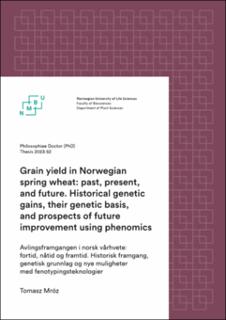| dc.contributor.advisor | Lillemo, Morten | |
| dc.contributor.advisor | Shafiee, Sahameh | |
| dc.contributor.advisor | Crossa, Jose | |
| dc.contributor.author | Mroz, Tomasz | |
| dc.coverage.spatial | Norway | en_US |
| dc.date.accessioned | 2023-05-31T09:32:11Z | |
| dc.date.available | 2023-05-31T09:32:11Z | |
| dc.date.issued | 2023 | |
| dc.identifier.isbn | 978-82-575-2081-6 | |
| dc.identifier.issn | 1894-6402 | |
| dc.identifier.uri | https://hdl.handle.net/11250/3069436 | |
| dc.description.abstract | Bread wheat is among the most critical staples worldwide and is essential to Norway’s food production. The aftermath of the green revolution nearly eradicated Norwegian wheat production in the 1950s and 1960s. The lack of fit between Norwegian wheat varieties at that time and the new agronomic practices rendered Norwegian wheat production uncompetitive, which spurred intense breeding efforts. The efforts resulted in the release of two landmark wheat varieties: Runar and Reno, released in 1972 and 1975, respectively, which brought back domestic wheat production in Norway. Since then, new varieties have been bred and released on the market, but we know little about the achieved breeding gains or their genetic background.
To fill this gap, we tested 21 historical and modern wheat varieties present on the Norwegian market since the release of Runar in a multi-year field trial under two fertilization levels (75 and 150 kg N ha-1). We detected an annual genetic progress in grain yield (GY) of 18kg ha-1 (0.34%), which did not rely on agronomic input. The progress was primarily associated with increased number of grains per spike and area. New varieties in Norway can also take advantage of the changing climate (earlier spring) by extending their vegetative periods by three days on average.
Genome-wide association analysis on a diverse panel of over 300 lines could not fully explain the genetic progress in GY. However, it discovered several significant loci associated with GY and other traits. Validation of these loci using recent breeding lines confirmed their effects and showed potential for using them in marker-assisted selection. Two loci, representing the Ta-Col5 and Ta-GS5-3A genes (associated with spike architecture and kernel size), showed a change in allele frequency over the last 100 years, indicating possible historical selection pressure.
We investigated the prospects of accelerating genetic gains using multispectral drone imaging data for standalone GY prediction and augmenting genomic selection models. The multispectral data allows for GY prediction with accuracy comparable to genomic data, and models using both genomic and phenomic variates appeared superior. We discussed the biological rationale behind this GY prediction and its practical aspects.
This work provides insight into historical changes in GY and other traits in Norwegian spring wheat, and describes a semi-novel way of using phenomic data for GY prediction and augmenting GP to accelerate genetic gains in GY. | en_US |
| dc.language.iso | eng | en_US |
| dc.publisher | Norwegian University of Life Sciences, Ås | en_US |
| dc.relation.ispartofseries | PhD thesis;2023:52 | |
| dc.rights | Attribution-NoDerivatives 4.0 Internasjonal | * |
| dc.rights.uri | http://creativecommons.org/licenses/by-nd/4.0/deed.no | * |
| dc.subject | Grain yield | en_US |
| dc.subject | Spring wheat | en_US |
| dc.subject | High-throughput phenotyping | en_US |
| dc.title | Grain yield in Norwegian spring wheat : past, present, and future : historical genetic gains, their genetic basis, and prospects of future improvement using phenomics | en_US |
| dc.title.alternative | Avlingsframgangen i norsk vårhvete : fortid, nåtid og framtid : historisk framgang, genetisk grunnlag og nye muligheter med fenotypingsteknologier | en_US |
| dc.type | Doctoral thesis | en_US |
| dc.description.version | publishedVersion | en_US |
| dc.subject.nsi | VDP::Agriculture and fishery disciplines: 900 | en_US |
| dc.relation.project | PhenoCrop (NFR 320090) | en_US |
| dc.relation.project | vPheno (NFR 267806) | en_US |

